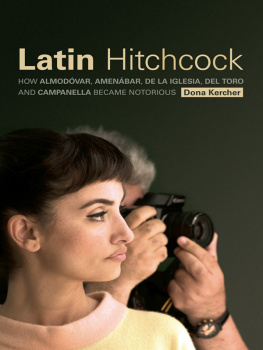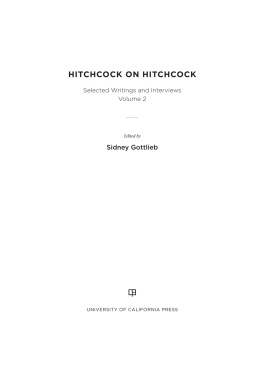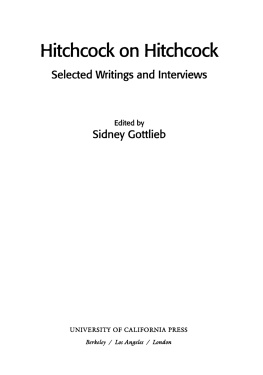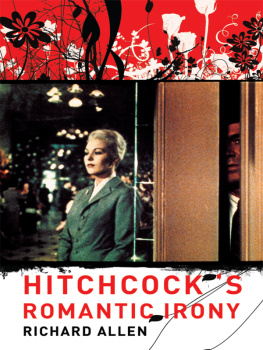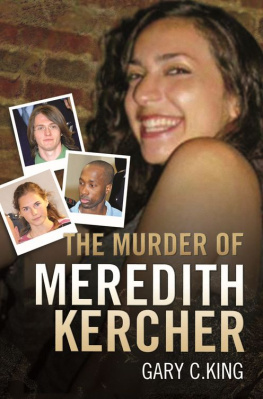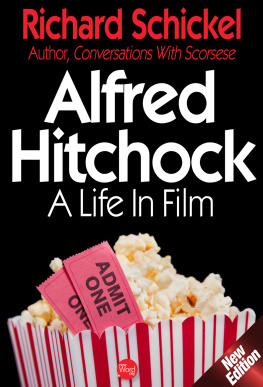Latin Hitchcock
Latin Hitchcock
HOW ALMODVAR, AMENBAR, DE LA IGLESIA, DEL TORO AND CAMPANELLA BECAME NOTORIOUS
Dona M. Kercher
A Wallflower Press Book
Published by
Columbia University Press
Publishers Since 1893
New York Chichester, West Sussex
cup.columbia.edu
Copyright Dona M. Kercher 2015
All rights reserved.
E-ISBN 978-0-231-85073-5
Wallflower Press is a registered trademark of Columbia University Press
Cover image:
On the set of Broken Embraces (2009)
photograph by Emililo Pereda Universal International Pictures / The Kobal Collection
A complete CIP record is available from the Library of Congress
ISBN 978-0-231-17208-0 (cloth : alk. paper)
ISBN 978-0-231-17209-7 (pbk. : alk. paper)
ISBN 978-0-231-85073-5 (e-book)
A Columbia University Press E-book.
CUP would be pleased to hear about your reading experience with this e-book at .
CONTENTS
ACKNOWLEDGEMENTS
I am drawn to think of the early scene in Vertigo when Madeleine goes for a drive with Scottie out to the California coast and visits the redwood forest. She points to the rings in a cross-section of a huge redwood trunk on display and asks if she has lived before, or not. Trying to fix in time all the layers that have made up this book, the product of about two decades, and all the encounters that have marked it, as well as the personal vicissitudes, is as difficult and at times troubling as Madeleines memory of history implies. It is hard to connect each ring to a specific event or path suggested in the romantic mystery of a books creation. Any omissions here are entirely due to my own uncertain perceptions, and not to the lack of significance of any contribution.
Without the encouragement of Marvin DLugo and Marsha Kinder, whose joint seminar on Spanish Film at Clark University set me on a journey to interpret film as film, I would never have begun to teach or publish on cinema. Marvin has been a steadfast mentor. I remain ever grateful for his counsel and encouragement. At that initial seminar I also met Kathleen Vernon, Susan Martin-Mrquez and Nancy Membrez, friends and models in the field of Hispanic cinemas from whom I continue to learn.
My academic life has likewise been immeasurably enriched by exchanges that have occurred during conferences, the multiple cycles of Cine-Lit in Portland, Oregon, the many panels at SCS, then SCMS, as well as LASA, not to mention more recently, Facebook. For their inspiration and support, I want to thank Guy Wood, Jaume Mart-Olivella, Malcolm Compitello, Robert Lang, Catherine Benamou, Tamara Falicov, Jeff Middents, Joo Vieira, Gilberto Blasini, Yeidy Rivero, Nura Triana Toribio, Verena Berger, Deborah Shaw and Rielle Navitski.
During regular trips to Madrid, I have felt at home, and well guided, at the Spanish Film Archives. From its generations of dedicated archivists and scholars I would like to thank Dolores Devesa, Alicia Potes, Javier Herrero, Miguel Valle Incln and Margarita Lobo. To the Ocho y Medio Bookstore, and its owners Mara Silveyro and the late Jess Robles, who was already talking of translating this book when it was in its early stages, I owe a great debt for their cinematographic publications and selections, as well as for their advice and unforgettable welcome. In Spain I would also like to thank Manuel Gutirrez Aragn, with whom interviews became an ongoing conversation, the organisers of the San Sebastin Film Festival for granting me cultural credentials, and my Basque family in Bilbao and Donostia for sharing their lives with me.
In the US I have benefited from the guidance of, and papers provided by, Jenny Romero of the USC Warner Archives, as well as from the assistance from librarians at the Widener Library, and at the University of Massachusetts Amherst. My home institution, Assumption College, has supported me through sabbaticals and Faculty Development grants for research. At Assumption I owe a special debt of gratitude to Tom Begley, who sadly passed away in 2014, for commenting on the early chapters of this book, as well as for sharing his joy in and immense knowledge of Spain and its cultural history with me over the years. For putting his faith in my project and supporting it through major pauses, I must thank Yoram Allon, Commissioning Editor at Wallflower Press.
To Elliot and Alisha, my son and daughter, whose intellects never cease to amaze me, I will always remember and cherish our times on research trips together in Madrid, Sevilla, Buenos Aires, Bogot and Hitchcocks San Francisco. Finally, to my husband Norman, mi Alma, who like Hitchcocks Alma is the unsung but true judge and editor, who has inspired and supported me always, all my love.
Even Spanish-language publications from Spain or Latin America such as Guillermo del Toros Alfred Hitchcock (1990) or Jos Luis Castro de Pazs Alfred Hitchcock (2000) notably lack any discussion of the influence of Hitchcock on films in Spanish. My aim in this volume is not to dress Alfred Hitchcock up in a charro hat or a traje de luces, though Mr. Hitchcock was certainly known to have enjoyed donning costumes and playing pranks, but to acknowledge, query and interpret the reception of Hitchcock in the Spanish-speaking world. To do so is to begin to understand important intersections of global and local cultures, and to trace these in terms of two languages, Spanish and English, which are on the ascendancy worldwide.
In the 1990s young Spanish directors, such as lex de la Iglesia, Julio Medem and Alejandro Amenbar, began to produce cine de terror, thrillers or suspense films. These films looked new and different and were immensely popular at the box office, a rarity for Spanish films in Spain. As a woman I saw this genre of films more often associated with young adolescent males as an obligation. Anticipating a transmigrated Scream (1996) franchise, I was not a happy camper going to see Da de la bestia (Day of the Beast, 1995) in Madrid the first time. Over the years I had company in my initial lack of enthusiasm. These Spanish thrillers were looked down upon by some filmmakers of the earlier generation. When I interviewed Manuel Gutirrez Aragn, one of the major filmmakers of the period of the transition to democracy (19751982), he spoke of the new cine de terror as technically brilliant, but devoid of ideas. My own attitude changed when I began first to look carefully at the aesthetics of these films, and second, to think in terms of a more general cultural landscape, about how these films interfaced with local and global referents. These thoughts became persistent as I taught film analysis through Amenbars popular Tesis (Thesis, 1996) in my classes, and published on humour and politics in lex de la Iglesias Muertos de risa (Dying of Laughter, 1998). When I chatted on the bus from the Spanish film archives about Rear Window (1954) with Spanish film students who had never heard of Laura Mulvey, just how differently Hitchcock has been received in Spanish film criticism became clear. This book traces where my classroom and mass transit experiences, and my subsequent archival research, have taken me.
While I had always thought of and taught the tradition of a particular satirical black humour, common both to Spanish film of the 1950s and to much of Buuel, the humour, which was so important to the cine de terror in the 1990s, was often quite different. Moreover, these were not just art house films in Spain. Thinking about the

